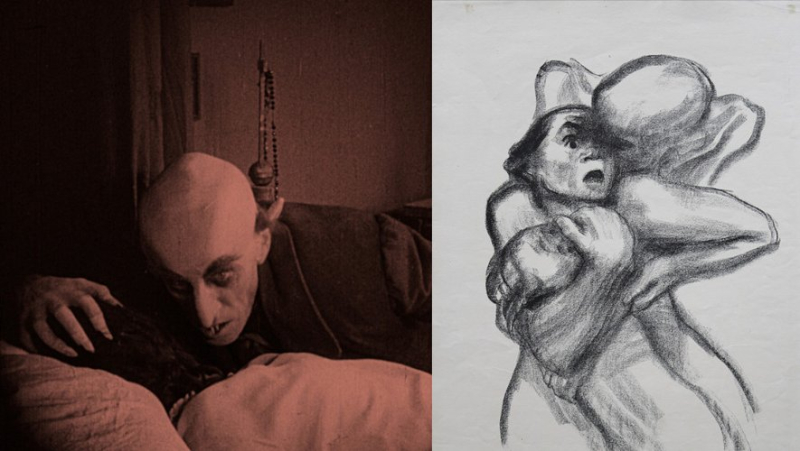“Psychoses, expressionism in art and cinema”: the dark and demented exhibition at the Lodève Museum

An extract from “Nosferatu the Vampire” by Friedrich Wilhelm Murnau (1921) is placed in dialogue with “Death Takes A Woman” by Käthe Kollwitz (1934). FRIEDRICH-WILHELM-MURNAU-STIFTUNG, WIESBADEN & STADTMUSEUM TÜBIGEN – Lodeve Museum
The fantastic new exhibition at the Musée de Lodève focuses on expressionism in art and cinema until September 15. Not to be missed!
"And when he had crossed the bridge, the ghosts came to meet him". The most famous intertitle in the history of cinema, which the surrealists made their password because it marks the passage from one world to the next The other, from the state of consciousness to that of dreams, belongs to the film Nosferatu the Vampire. And here we are, having barely crossed the threshold of the new exhibition at the Lodève Museum (well before seeing the first extract of the said masterpiece by Friedrich Murnau) that its magical formula comes back to mind… and that the spirits too.
Until September 15, the exhibition “Psychoses” is interested in expressionism, in painting, graphic arts and cinema, highlighting throughout his career, the crossed influences between each.
The art of exasperation
Essentially German, and initially pictorial, the expressionist movement (a real false movement, in this case, and plural) was born at the turn of the 20th century from the rejection of forms considered bourgeois, academic and alienating; namely impressionism, symbolism, naturalism. While remaining predominantly figurative, the expressionists claimed a subjective representation which places emphasis on « the intensity of expression », by the exasperation of forms, contrasts, subjects…
At first quietly worked by the tensions generated by industrialization and by the new torments of urbanization, expressionism took a more angry, rebellious, nightmarish turn after the First World War. Between the concrete horrors and secret traumas of war, the social malaise in a defeated and bloodless country, and the rise of the psychoanalytic approach to neuroses and psychopathologies, the inspiration is optimal…hellip ; but pessimistic. This is where, like lightning, very briefly but very intensely, expressionist cinema explodes. Its crazy phosphenes still haunt retinas and screens a century later.
A journey in three stages
Complete with 120 works of art, 50 still images and 15 extracts from emblematic films, the Lodevo exhibition covers its journey in three stages.
The first, “Departure and rupture”, highlights the moment of change between the rural and the urban, between nature and the machine, between man and the monster. After a first room suggesting a remainder of harmony, a projection of Metropolis by Fritz Lang (1927) welcomes us into the next room, devoted to the city, source of all the most exotic fantasies , exciting, but also the most horrifying. The Speaker by Arthur Segal (1917) and Return of the Coal Miners by Conrad Felix Müller (1920) seem to anticipate the nightmare Lang's futuristic totalitarianism. Further on, it's Nosferatu that awaits us in the darkness (obviously), and on the picture rails, among others, the mind-blowing drawing The Ideologues by Max Beckmann ( 1920), the engraving The Pleasure Assassin by’Otto Dix (1920), the insane and sublime pieces of Kätte Kollwitz…
The second sequence, “Dream and trauma” (in German, the play on words is more convincing: Traum und Trauma) focuses on the representation of the disturbances of the psyche up to the inward collapse of the interior ;individual but also society. With impressive images from the films On the Nerves by Robert Reinert (1919), From Dawn to Midnight by Karlheinz Martin (1920) and The Doctor's Cabinet Caligari by Robert Wiene (1920) responds, in particular, to the paradoxically soft and dark pastels of Erich Drechsler and the fantastic paragons of darkness by Bernhard Kretzschmar.
Finally, the last section, “Form and Deformation” returns to the formal language of Expressionism itself: the science of dynamic composition, the violence of its chiaroscuro, the exaggeration of physiognomies, the distortion of perspectives… so many techniques for making a state of mind here perceptible, a state of the world there. A striking comparison between an image of Paul Weneger's Golem (1920) next to a self-portrait by Wilhelm Morgner, a stunning collision between an extract from Friedrich Murnau's The Last of Men (1924) and urban visions by Lyonel Feininger, Ludwing Meidner…
In truth, other associations come to mind. With film noir, gothic cinema. comics, dance, metal, manga… Since when we entered “Psychoses”, we crossed the ” bridge », other ghosts keep coming to meet us. Go the other way: go ahead, let yourself be haunted!
I subscribe to read the rest




